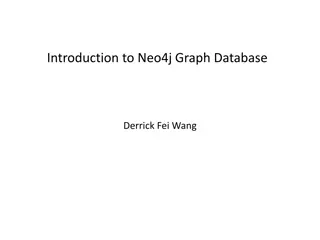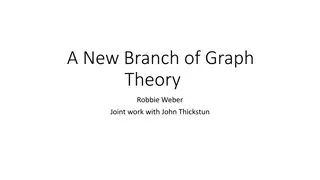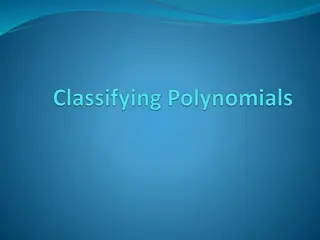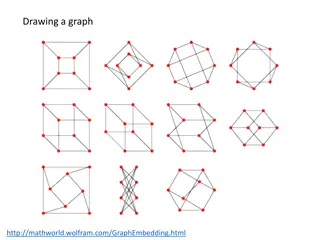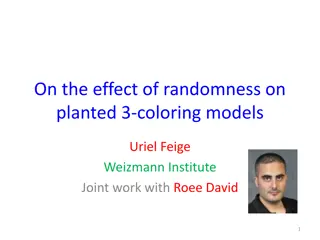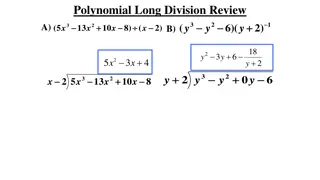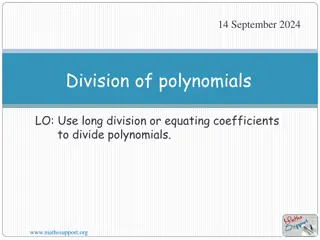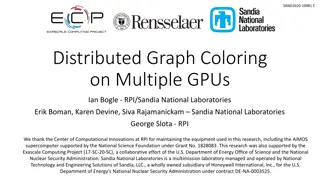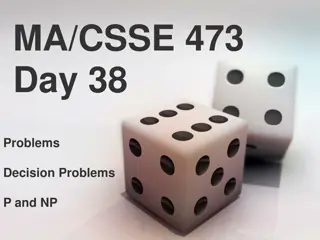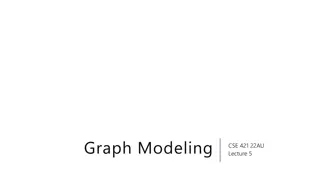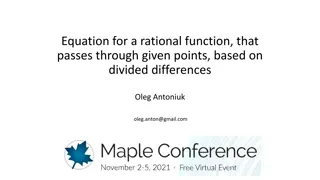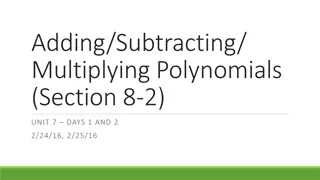Strong List Coloring and the Polynomial Method in Graph Theory
Exploring the Polynomial Method in the context of Strong List Coloring, Group Connectivity, and Algebraic tools. This method involves proper coloring of graphs based on polynomial assignments, highlighting the significance of Strong Choosability and the Co-graphic case. The applications and proofs associated with this methodology provide insights into graph theory robustness and connectivity.
Uploaded on Sep 18, 2024 | 2 Views
Download Presentation

Please find below an Image/Link to download the presentation.
The content on the website is provided AS IS for your information and personal use only. It may not be sold, licensed, or shared on other websites without obtaining consent from the author.If you encounter any issues during the download, it is possible that the publisher has removed the file from their server.
You are allowed to download the files provided on this website for personal or commercial use, subject to the condition that they are used lawfully. All files are the property of their respective owners.
The content on the website is provided AS IS for your information and personal use only. It may not be sold, licensed, or shared on other websites without obtaining consent from the author.
E N D
Presentation Transcript
Strong list coloring, Group connectivity and the Polynomial method Michael Tarsi, Blavatnik School of Computer Science, Tel-Aviv University, Israel
The Polynomial Method (Alon, T) The Graphic case PG= (xi xj) over all edges (i,j) E A proper coloring of G an assignment of colors to the xi s for which PG 0
The main Algebraic tool P(x1,x2, ,xn) homogeneous Cx1e1x2e2 xnena monomial in the expansion of P, with a nonzero coefficient C 0 More than eivalues to select a color from, for each xi There exists a proper coloring , that is, a feasible vector X such that P(X) 0 (A multivariate version of A polynomial of degree n has at most n distinct roots )
Too Strength Too weak The (graphic) polynomial method is about List coloring (choosability) Furthermore, It is about Strong list coloring That is, each edge e has its own forbidden difference bebetween the two colors of its endvertices, not necessarily 0.
Proof: For every edge e a new variable be. P~G the product over E of (xi xj be). P~k3=(x-y-b1)(y-z-b2)(z-x-b3) P~ Clearly contains all terms of PG, (e.g. x2y), where the exponent of each beis 0. Any single value can hence be imposed on each be, by the main Algebraic tool. (A multivariate version of A polynomial of degree n cannot rich the same value more than n times )
Strong Choosability is indeed strong e.g. unlike mere chosability (and coloribility), strong choosability does count multiple edges.
The Co-graphic case Nowhere Zero flows Definition (Tutte 1956) A k-Nowhere Zero Flow in a graph is an assignment of a {1,2, ,k-1} value to every edge, such that the (directed) sum at each vertex (hence, every cut set) equals zero.
PG*=x1x2x3x4x5(x1+x3+x4)(-x1-x2)(-x4+x5)(x2-x3-x5) PG* 0 NZF
Solution Let it all be modulo k
But A pol. of degree n has at most n roots is essential.
Hence, limited to Fields, GFk, when k is a prime power 2,3,4,5,..7,8,9 Good enough.
Group connectivity Again, what we actually get is MORE than mere NZF: Definition (Jaeger, Payan, Linial, T) Let A be an abelian group. A graph is A- connected if for any assignment of forbidden values, one for each edge, there exists a feasible A-flow.
Example Any even wheel is Z3 connected Proof by example: PW4*=xyzt (x-y)(y-z)(z-t)(t-x), and 2x2y2z2t2 is a monomial in its expansion
Interesting Any even wheel is also Strongly Z3-choosable Proof: A k-coloring is an assignment of values from sum abelian group of order k, to EDGES, which sums up (with some arbitrary orientation) to zero on every cycle.
Via matrix representation PK4=(x-y)(x-z)(x-w)(y-z)(y-w)(z-w) = ni=1 mj=1ai,jXj x y z w a. 1 -1 0 0 b. 1 0 -1 0 c. 1 0 0 -1 d. 0 1 -1 0 e. 0 1 0 -1 f. 0 0 1 -1
The General case Given an nxm matrix A=(ai,j), its polynomial PA is defined by ni=1 mj=1ai,jXj PA(X) is the product of the n entries of the vector AX Originally motivated by: Conjecture (Jaeger ~1980): For every Non singular nxn A over GFq, where q 4, there exists a vector X, such that both X and AX have no zero entry. True for every non prime q (Alon, T)
Matrix manipulations Replacing A by AT, where A is non singular mxm means change of variables . Over GFk, the new matrix and its polynomial are as good as the original. The chromatic number, NZF number, group connectivity and more, are all, in that sense, classical 19th century algebraic INVARIANTS (though, mostly over finite fields). Changing variables does help. e.g. (x-y)(x+y) quadratic xy linear
Seymour (1981), gave the following structural characterization of 3-connected cubic graphs on 2n vertices and 3n edges: The entire graph can be obtained from a certain co-tree by repeatedly adding cycles, each containing at most two new edges.
When algebraically translated and after an appropriate change of variables, it gives a co-graphic matrix representation of the following type (sort of): 1 0 0 0 Identity matrix 0 1 0 0 representing 0 0 1 0 0 0 0 1 1 0 0 0 Triangular x 1 0 0 a tree x x 1 0 x x x 1 y y y y Non singular y y y y the corresponding y y y y co tree Y y y y
On 1987 we proved that, over GF5, for such a matrix A, there exists a vector x such that Ax has no zero entry. This result positively settled Tutte s 5-NZF Conjecture, still open for almost 50 years. We proved more:
The Tree plus 2-degenerate graph conjecture A graph is (1,2)-composed if its edge set is the union of a spanning tree and a 2-degenerate graph.
Example 0 a b c d e -1 1 0 0 0 0 0 -1 1 0 0 0 0 -1 0 1 0 0 BLUE 0 0 0 -1 1 0 0 0 0 0 -1 1 -1 1 0 0 0 0 -1 0 1 0 0 0 0 0 -1 1 0 0 GREEN 0 0 0 -1 1 0 0 -1 0 0 0 1 And a non-singular READ
Conjecture(s) 1. The polynomial of a Non-singular + Triangualr Matrix admits a term where all exponents are at most 3. 2. Every 3-connected graph is Z5-connected, in particular, the assertion of Tutte s 5-NZF conjecture. The above Implies: 3. Every (1,2)-composed graph is Strongly 5-choosable, in particular 5-choosable, in particular 5-colorable. Either 2 or 3, strong or week version, may be true while the other wrong
Some of Tuttes Seminal Conjectures There exists a positive integer k, such that every (bridgeless) graph admits a k-NZF Every graph admits a 5-NZF There exists a positive integer t, such that every t- edge connected graph admits a 3-NZF Every 4-edge connected graph admits a 3-NZF
The 8-NZF Theorem (F.Jaeger 1975) Every graph admits an 8-NZF Equivalently, every graph can be covered by three Cycles (a cycle = an edge disjoint union of simple circuits)
The 6-NZF Theorem (P. Seymour 1981) Every graph admits a 6-NZF
Conjecture (1987) The Union of a tree and a 2-degenerate graph is always 5-colorable.
A Stronger version For any pair of nxn non singular A and B there exists an nxn sub matrix of the nx2n A|B, with no zero Permanent. If True over GF3 it implies Tutte s 3-NZF Conjecture, with t=6




